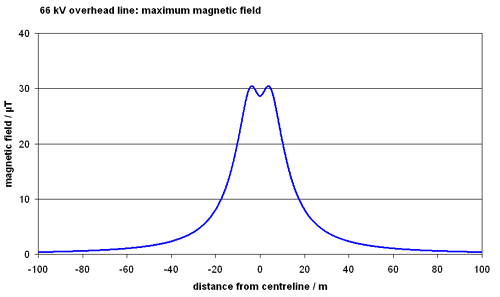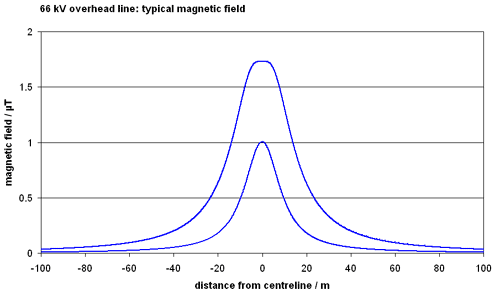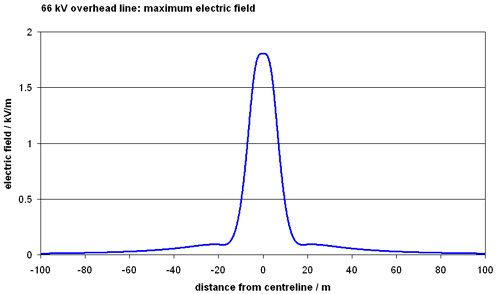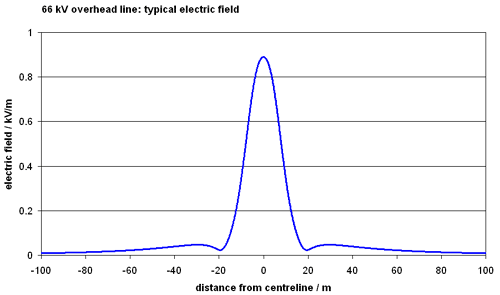66 kV lines are not very common in the UK. They are often built using one of the 132 kV line designs, so the magnetic field is the same as for 132 kV. 132 kV overhead lines are usually carried on lattice steel pylons, but smaller than used for 275 kV and 400 kV lines. Sometimes they are carried on wood poles.
Magnetic field
The maximum field is produced by the largest design of line – the L7 – when the ground clearance is the minimum allowed – 7.0 m – and the loads are the highest allowed – 1.4 kA in each circuit. The field also depends on the phasing. 66 kV lines usually have Untransposed (U) phasing.

Typical fields are lower than the maximum field because the clearance is usually higher and the loads are usually lower. The two curves shown here are for typical loads, the normal U phasing, and two different line designs: a lattice steel pylon, L132 (the higher field), and a wood-pole design (the lower field).

This table gives some actual field values for the same conditions.
magnetic field in microtesla at distance from centreline | |||||||||
|---|---|---|---|---|---|---|---|---|---|
maximum under line | 10 m | 25 m | 50 m | 100 m | |||||
66 kV | largest lines | L7 | maximum | clearance 7 m | 30.445 | 20.532 | 5.553 | 1.528 | 0.392 |
typical | clearance 10 m | 1.848 | 1.359 | 0.468 | 0.138 | 0.036 | |||
smaller lines | L132 | maximum | clearance 7 m | 24.585 | 17.217 | 4.587 | 1.247 | 0.318 | |
typical | clearance 10 m | 1.731 | 1.317 | 0.451 | 0.132 | 0.034 | |||
smallest wood-pole design | trident | maximum | clearance 7 m | 12.347 | 12.347 | 0.738 | 0.192 | 0.048 | |
typical | clearance 10 m | 1.764 | 0.385 | 0.099 | 0.027 | 0.007 | |||
Note:
1. All fields calculated at 1 m above ground level.
2. All fields are given to the same resolution for simplicity of presentation (1 nT = 0.001 µT) but are not accurate to better than a few percent.
3. Calculations ignore zero-sequence current. This means values at larger distances are probably underestimates, but this is unlikely to amount to more than a few percent and less closer to the line.
4. The “maximum field under the line” is the largest field, which is not necessarily on the route centreline; it is often under one of the conductor bundles.
5. Sometimes, a 66 kV circuit could be carried on a line designed for 275 kV or 400 kV. Then the magnetic fields could be larger than shown here. Or it could be carried on a one-off wood pole design, but the fields would probably be similar to those shown here.
Electric field
The maximum field is produced by the largest design of line – the L7 – when the ground clearance is the minimum allowed – 7.0 m. The field also depends on the phasing. 66 kV lines usually have Untransposed (U) phasing.

Typical fields are lower than the maximum field because the clearance is usually higher. The curve shown here is for the normal U phasing, and a typical medium-size lattice steel pylon.

This table gives some actual field values for the same conditions.
electric field in V m-1 at distance from centreline | |||||||||
|---|---|---|---|---|---|---|---|---|---|
maximum under line | 10 m | 25 m | 50 m | 100 m | |||||
66 kV | largest lines | L7 | maximum | clearance 7 m | 1808 | 456 | 91 | 40 | 12 |
smaller lines | L132 | typical | clearance 10 m | 890 | 345 | 43 | 30 | 9 | |
Note:
1. All fields calculated at 1 m above ground level.
2. All electric fields are calculated for the nominal voltage. In practice, voltages (and hence fields) may rise by a few percent.
3. All electric fields calculated here are unperturbed values.
4. All fields are given to the same resolution for simplicity of presentation (1 V/m) but are not accurate to better than a few percent.
5. Calculations ignore zero-sequence voltages. This means values at larger distances are probably underestimates, but this is unlikely to amount to more than a few percent and less closer to the line.
6. The “maximum field under the line” is the largest field, which is not necessarily on the route centreline; it is often under one of the conductor bundles.
7. Sometimes, a 66 kV circuit could be carried on a line designed for 275 kV or 400 kV. Then the electric fields could be larger than shown here. Or it could be carried on a one-off wood pole design, but the fields would probably be similar to those shown here.
Underground cables
66 kV is not a common voltage, and 66 kV underground cables are even rarer. Where they exist, they would be similar to 132 kV underground cables